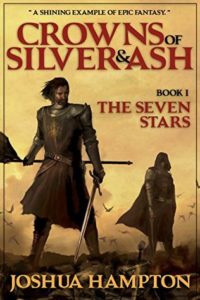23 Mar Outlines, Medieval Dialogue, and Music: An Interview with Joshua Hampton
My first interview as a fantasy author! Does this mean I’m famous now?
Joshua Hampton Interview – Outlines, Medieval Dialogue, and Music
What was your inspiration for this series?
I’ve been a huge fantasy fan for as long as I can remember. I watched the Rankin & Bass animated versions of The Hobbit and The Return of the King so many times I had them memorized, and I first read The Lord of the Rings in elementary school. So when the Peter Jackson films came out in the early 2000s, I reread the original books and just felt so inspired to write something similar. I’d dabbled in writing crime dramas and historical fiction but was never 100% happy with the results. But once I tried my hand at fantasy, I was really surprised by how much I loved it.
Your characters speak as those living during the medieval times would have. How much research did you have to do on medieval words and dialogue?
There definitely was a strict commitment to using that kind of language. No anachronisms. No modern words or even words that sound modern. I want the reader to pick up Crowns of Silver & Ash and not really know whether it was written five days ago or five centuries. And finding ways to explain things in unique ways, without falling back on many of the words we now use in our everyday lives was definitely a challenge. It took lots of research and many trips to the library. Old European songs and poetry, like the Child Ballads (http://www.sacred-texts.com/neu/eng/child/), were also a great resource. I read and listened to everything I could get my hands on, and did my best to absorb as much as I could. I’d take notes when I came across a turn of phrase or antiquated word I thought might be helpful—and I had hundreds of pages of these notes that I constantly referred to in an effort to keep both the dialogue and the prose fresh yet true to the vision.
 Which scene was your favorite? Which scene was the most difficult for you to write?
Which scene was your favorite? Which scene was the most difficult for you to write?
My favorite scenes are the ones that ended up being different than originally intended. There are several plot points in the books that are nothing like I’d planned them to be. I’d hate to give away specifics, but, for example, there are characters that were supposed to make it to the end who are killed off far earlier. And their deaths were as much as a surprise to me as I hope they are to the reader! For some reason, the story just took me in a different direction and I went with it.
Songs and music play such a vital role in the story. How did that come to be?
It was a natural thing. I’ve been a musician my whole life. Everyone in my family sings and plays some kind of instrument or another. And I find that the kind of stuff I grew up on—folk music and bluegrass mostly—was so heavily influenced by the Scottish, Irish, and English tradition that it was an easy transition to take that kind of musical style and adapt it to the world I was creating. Most of the songs in the book could easily be bluegrass tunes or sung by a little three-piece band in an Irish pub somewhere. In fact, a few of the songs I’ve actually written melodies for as well. Who knows? Maybe someday I’ll make a Songs from Andulen compilation to sell on the Home Shopping Network or something. Okay, maybe not.
 While writing, did you use charts or notes or an outline to keep yourself from becoming confused about where you were at in the book?
While writing, did you use charts or notes or an outline to keep yourself from becoming confused about where you were at in the book?
Yes, I always work from an outline. Not only do I have a written outline that details each chapter, but I make a visual outline as well. With a story as complex as Crowns of Silver and Ash, with all the various storylines, the visual outline is a quick way to keep track of how everything fits together. Of course, as I mentioned before, I don’t always stick to the outline. I use it as a guide, but if I’m writing and the story takes me some place else, I go with it. That can mean hours reworking the outline, but I always find it’s worth it.
What is your favorite genre in which to write?
I’ve written fiction in a variety of styles, but never really felt truly comfortable with any of it. It was actually with a friend’s encouragement that I wrote my first fantasy story and it felt so natural. And also for the first time, I knew it was really good. I’ve always loved fantasy books and movies: the chivalry, the good vs. evil dynamic, swords and shimmering plate mail, and all the rest. Fantasy was the natural next step for my growth as a writer and honestly, now I can’t imagine writing in any other genre. The language, the freedom to invent, and the world building keeps me interested and inspired.
Cormac McCarthy is an all-time favorite. Tolkien, of course. Frank Herbert’s Dune is just mind blowing in its originality and complexity. I love Robert E. Howard’s stories for the visceral feel, the way he so vividly paints the world his characters inhabit. I was a latecomer to George R. R. Martin’s work, though admittedly his stuff had a huge influence on Crowns of Silver & Ash. Serious fantasy for mature readers has always been what I was striving for. In terms of more classical stuff, I like to think Crowns of Silver & Ash is a mix of the Arthurian legend and Beowulf. I really tried to bring those two worlds together.
Books like Abundance by Sena Jeter Naslund or Nobokov’s Lolita also had a big influence in terms of the language used and the way the story was told. To me, a book’s not truly great unless I read nearly every sentence in awe of the craft behind it. I didn’t accomplish that by any means, but I like to think there are few good lines in there!
How do you manage to balance your time between work, family, friends, and writing?
It’s not easy. I write for a living, so often after a long day at the keyboard, I’m completely drained. The last thing I want to do is spend another minute in front of a computer screen. But my stories are always in the back of my mind somewhere. I’m always thinking about them, jotting down ideas or changes. So I steal every moment I can to research, write, edit, or proofread. I make sure to do at least a little work each day, whenever I can.
If you could spend one hour with just one person, dead or alive, whom would you choose? Why?
I love this question! There are so many. Tea with Tolkien sounds pretty incredible. So does coffee with Bob Dylan or a steak with Cormac McCarthy. But if I had to choose just one it would be film director Martin Scorsese. He’s been a hero of mine since I was in high school and I am fascinated by the way his mind works. The way he’s able to translate a screenplay into moving pictures in a unique and entertaining way is fascinating to me. Plus, he’s quite the talker, known for his rapid-fire way of speaking. He’d definitely fit a lot into that hour.
Do you have any advice for writers who aren’t yet published?
Stick with it—and don’t settle for mediocre. Edit, re-edit and edit again. And never be satisfied with the first thing you put on paper. It’s good to doubt what you’re doing because doubt makes you better. It makes you want to improve. Just don’t let it paralyze you. It takes time to find your voice, but once you do you’ll know it—and that’s when the real writing begins.


Sorry, the comment form is closed at this time.